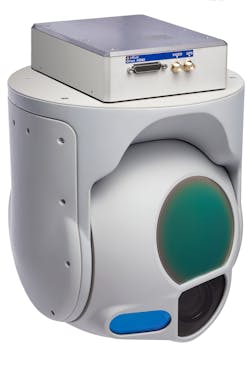Broadcast-quality video streaming coming soon to small unmanned aircraft with new H.265 compression
HOOD RIVER, Ore. – Electro-optical sensors experts at Trillium Engineering LLC in Hood River, Ore., are working to bring broadcast-quality high-resolution video streaming capabilities to relatively small military unmanned aerial vehicles (UAVs).
Trillium experts have tested the company's eight-inch camera gimbal using the new H.265 video compression standard, which has the potential to bring high-resolution, long-range video streaming to U.S. military Group 2 UAVs, which describe unmanned aircraft that weigh between 21 and 55 pounds.
The test, done last August controlled the Trillium HD80-MV visible-light and infrared camera gimbal from a laptop computer on the ground. Group 2 UAVs are about the size of the catapult-launched Boeing Insitu ScanEagle.
The H.265 video compression standard also is called High Efficiency Video Coding (HEVC), or MPEG-H Part 2. This compression approach, which requires advanced image processing computers, offers 25 to 50 percent better data compression at the same level of video quality, or substantially improved video quality at the same bit rate as its predecessor, H.264.
Related: The UAV video problem: using streaming video with unmanned aerial vehicles
Military surveillance UAVs must be able to fly far enough away from their ground controller stations to maintain stealth and security, while keeping the quality of the video good enough to meet analyst needs, explains Rob Gilchrist, co-founder and president of Trillium Engineering.
H.265 encoding has been around for a couple of years in the broadcast industry, yet only recently has it become efficient enough to fit on small camera gimbals suitable for Group 2 UAVs. By next year Gilchrist says Trillium engineers will be able to package H.265 encoding on the company's four-inch gimbals, and in about two years will be able to use H.265 on the company's 2.5-inch gimbals.
That means that within two years H.265-quality video streaming will be available to U.S. military Group 1 UAVs, which typically are small electric hand-launched aircraft that weigh no more than 20 pounds.
Two factors come together to enable H.265 video aboard small UAVs: the algorithm behind the encoding, and the shrinking size, weight, and power consumption (SWaP) of high-performance embedded computing, Gilchrist explains.
"It allows us to capture better imagery from a farther distance away," he says. "These are tens to hundreds of miles away, where the end-user can push out and execute missions from greater distances, and it gives engineers who select datalinks more flexibility."
Trillium engineers also are exploring a proprietary implementation of H.265 to enable video streaming from UAVs to relay over Iridium satellite links to provide wordwide coverage. "Clearly that opens a lot of flexibility in operations," Gilchrist says.
Related: Rugged XMC module for multi-stream video compression introduced by GE for military ISR
The August tests aboard a Cessna small general-aviation aircraft were able to demonstrate the quality of H.265 video. "When the plane was in the air, we reduced the bit rate to mimic a UAV that was further away," Gilchrist says. "Then we switched the standard from H.264 to H.265. The difference in the picture was remarkable."
The streaming midwave infrared and visible-light camera video was 50 percent clearer during the August tests than what cameras on Group 2 UAS normally produce, Gilchrist says.
For more information contact Trillium Engineering online at https://trilliumeng.com.

